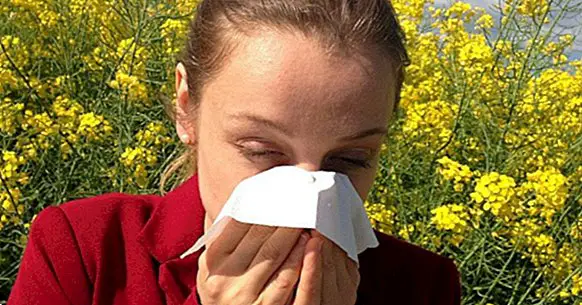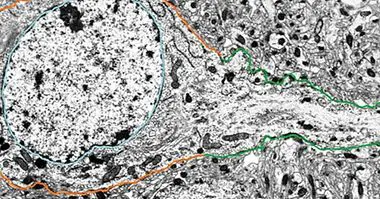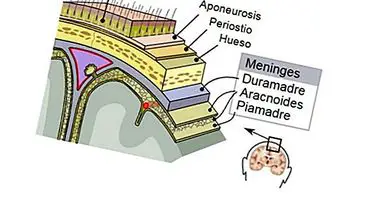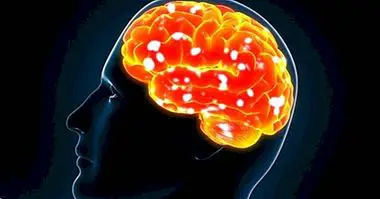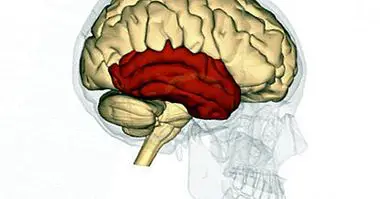Histamine: functions and associated disorders
Histamine is a molecule that acts in our body both as a hormone and a neurotransmitter, to regulate different biological functions.
It is present in significant amounts in both plants and animals, and is used by the cells as messenger . In addition, it has a very important role both in allergies and in cases of food intolerance and in the processes of the immune system in general. Let's see what their secrets are.
History of his discovery
Histamine was first discovered in 1907 by Windaus and Vogt, in an experiment where they synthesized it from imidazole propionic acid, although it did not know that it existed naturally until 1910, when they saw that the ergot fungus made it.
From this they began to study their biological effects. But it was not until 1927 when it was finally discovered that histamine is found in animals and in the human body . This happened when the physiologists Best, Dale, Dudley and Thorpe managed to isolate the molecule from a fresh liver and lung. And it is here when it received its name, since it is an amine that is significantly found in tissues (histo).
Synthesis of histamine
Histamine is a B-amino-ethyl-imidazole, a molecule that is made from the essential amino acid histidine, that is, this amino acid can not be generated in the human body and must be obtained by feeding . The reaction used for its synthesis is a decarboxylation, which is catalyzed by the enzyme L-histidine decarboxylase.
The main cells that carry out the manufacture of histamine are mast cells and basophils , two components of the immune system that store it inside it inside granules, along with other substances. But they are not the only ones that synthesize it, so do the enterochromaffin cells of both the pylorus region, and the neurons of the hypothalamus area.
Mechanism of action
Histamine is a messenger that acts as both a hormone and a neurotransmitter, depending on what tissue is released. As such, the functions that it activates will be carried out also thanks to the action of the histamine receptors . Of the latter there are up to four different types, although there may be more.
1. H1 receiver
This type of receiver is distributed throughout the body. It is located in the smooth muscle of the bronchi and intestine , where histamine reception causes bronchoconstriction and an increase in bowel movements, respectively. It also increases the production of mucus by the bronchi.
Another location of this receptor is found in the cells that form the blood vessels, where it causes vasodilation and an increase in permeability. Leukocytes (that is, cells of the immune system) also have H1 receptors on its surface, which serve to address the area where histamine has been released.
In the Central Nervous System (CNS), histamine is also captured in different areas by H1, and this stimulates the release of other neurotransmitters and acts in different processes, such as sleep regulation.
2. H2 receiver
This type of histamine receptor it is located in a group of specific cells of the digestive tract, specifically the parietal cells of the stomach . Its main function is the production and secretion of gastric acid (HCl). The reception of the hormone stimulates the release of the acid for digestion.
TIt is also located in cells of the immune system, such as lymphocytes. , favoring its response and proliferation; or in the mast cells themselves and basophils, stimulating the release of more substances.
3. H3 receiver
This is a receptor with negative effects, that is, it inhibits processes when receiving histamine . In the CNS, the release of different neurotransmitters, such as acetylcholine, serotonin or histamine itself, decreases. In the stomach inhibits the release of gastric acid, and in the lung prevents bronchoconstriction. So, as with many other elements of the organism of the same type, does not fulfill a fixed function, but has several and these depend largely on its location and the context in which it works.
4. H4 receiver
It is the last receptor for discovered histamine, and it is still not known what active processes . There are indications that it presumably acts in the recruitment of blood cells, since it is found in the spleen and thymus.Another hypothesis is that it participates in allergies and in asthma, since it is located in the membrane of eosinophils and neutrophils, cells of the immune system, as well as in the bronchus, so that it is exposed to many particles that come from outside and can generate a chain reaction in the body.
Main functions of histamine
Among its performance functions we find that it is essential to favor the response of the immune system and that works at the level of the digestive system regulating the gastric secretions and the motility of the intestine. As well acts on the central nervous system regulating the biological rhythm of sleep , among many other tasks in which she participates as a mediator.
Despite this, histamine is well known for another less healthy reason, since is the main one involved in allergic reactions . These are reactions that appear before the invasion of the own organism by certain particles other people's to this, and it can be born with this characteristic or it can get to be developed in some concrete moment of the life, from which it is little frequent that it disappears . Much of the western population suffers from allergies, and one of its main treatments is to take antihistamines.
Now we will go into more details about some of these functions.
1. Inflammatory response
One of the main known functions of histamine occurs at the level of the immune system with the generation of inflammation, a defensive action that helps isolate the problem and fight against it . To be able to start it, mast cells and basophils, which store histamine inside, need to recognize an antibody, specifically Immunoglobulin E (IgE). Antibodies are molecules produced by other cells of the immune system (B lymphocytes), and are capable of join elements unknown to the body, the so-called antigens .
When a mast cell or basophil finds an IgE bound to an antigen, it initiates a response against it, releasing its contents, being among these the histamine. The amine acts on the nearby blood vessels, increasing the volume of blood by vasodilation and allowing the exit of liquid to the detected area. In addition, it acts as chemotaxis on the other leukocytes, that is, it attracts them to the place. All this results in inflammation , with its blush, heat, edema and itching, which are nothing more than an unwanted consequence of a process necessary to maintain a good state of health, or at least try.
2. Regulation of sleep
The histaminergic neurons, that is to say, that release histamine, are located in the posterior hypothalamus and tuberomamilar nucleus. From these areas, they extend into the prefrontal cortex of the brain.
As a neurotransmitter, histamine prolongs the waking state and reduces sleep , that is to say, that it acts opposite to melatonin. It is shown that when you are awake, these neurons are activated quickly. In time of relaxation or fatigue work less and are deactivated during sleep.
To stimulate wakefulness, histamine makes use of H1 receptors, while inhibiting it by means of H3 receptors. A) Yes, H1 agonist drugs and H3 antagonists are a good way to treat insomnia . Conversely, H1 antagonists and H3 agonists can be used to treat hypersomnia. This is why antihistamines, which are antagonists of the H1 receptors, have somnolence effects.
3. Sexual response
It has been seen that during orgasm there is a release of histamine in mast cells located in the genital area . Some sexual dysfunctions are associated with the lack of this release, such as the absence of orgasm in the relationship. Therefore, excess histamine can cause premature ejaculation.
The truth is that the receiver that is used to carry out this function is currently unknown and is subject of study; It is probably a new one and one of which will have to be known more as the investigations in this line advance.
Major disorders
Histamine is a messenger that is used to activate many tasks, but It is also involved in anomalies that affect our health .
Allergy and histamines
One of the main disorders and most commonly associated with the release of histamine is Type 1 hypersensitization, a phenomenon better known as allergy .
The allergy is an exaggerated response to a foreign agent called allergen , that in a normal situation should not originate this reaction. It is exaggerated, because very little is needed to generate the inflammatory response.
The typical symptoms of this anomaly, such as respiratory problems or lowering of blood pressure, are due to the effects of histamine on H1 receptors. Thus, antihistamines act at the level of this receptor, not allowing the binding of histamine to them .
Alimentary intolerance
Another anomaly associated with histamine is food intolerance. In this case, the problem occurs because the digestive system is unable to degrade the messenger found in food Due to the absence of the enzyme that carries out this task, DiAmina Oxidase (DAO). This may have been deactivated by a genetic or acquired dysfunction, in the same way that intolerance to dairy products occurs.
Here the symptoms are similar to those of an allergy , and is believed to occur because there is an excess of histamine in the body. The only difference is that there is no presence of IgE, since mast cells and basophils do not participate. Histamine intolerance can occur more frequently if you suffer from diseases related to the digestive system.
Bibliographic references:
- Blandina, Patrizio; Munari, Leonardo; Provensi, Gustavo; Passani, Maria B. (2012). "Histamine neurons in the tuberomamillary nucleus: a whole center or distinct subpopulations?". Frontiers in Systems Neuroscience. 6
- Marieb, E. (2001). Human anatomy & physiology. San Francisco: Benjamin Cummings. p. 414
- Nieto-Alamilla, G; Márquez-Gómez, R; García-Gálvez, AM; Morales-Figueroa, GE; Arias-Montaño, JA (November 2016). "The Histamine H3 Receptor: Structure, Pharmacology, and Function". Molecular Pharmacology. 90 (5): 649-673.
- Noszal, B .; Kraszni, M .; Racz, A. (2004). "Histamine: fundamentals of biological chemistry". In Falus, A .; Grosman, N .; Darvas, Z. Histamine: Biology and Medical Aspects. Budapest: SpringMed. pp. 15-28.
- Paiva, T. B .; Tominaga, M .; Paiva, A. C. M. (1970). "Ionization of histamine, N-acetylhistamine, and their iodinated derivatives". Journal of Medicinal Chemistry. 13 (4): 689-692.

